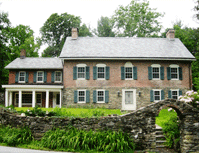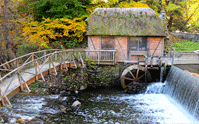Gomez Articles
The
Gomez Family: An Old Family Record
The Search for the Gomez
Past: Old Castile to Newburgh, N.Y.
A Few of the Books Published
by Benjamin Gomez
Don't Forget The Cousins
Benjamin
Gomez — Bookseller
The
Gomez Collection
Gomez
Family Prayer Book
Act
of Denization from Queen Anne Recorded for Luis Gomez
Queen
Anne
|
The Search for the Gomez Past:
Old Castile to Newburgh, N.Y.
Residents from 1772-1799
A Talk
by Professor C. Saienz at the Spring Meeting of the Friends
of Mill House - 1997
Luis Moses Gomez, undoubtedly known in his lifetime as Luis Moysen, is a major figure in the colonial history of New York, and in the history and development of the Atlantic's Spanish-Portuguese Jewish community during the first half of the eighteenth century. His many descendants are well aware of Luis Moysen's and his sons' historical contributions, but they have long wondered about the family tradition based on "an old family record" written by Isaac Gomez, a great grandson of Moses through sons Daniel and Isaac, that states Luis Moysen's father was a member of the Spanish Court in Madrid and a particular favorite of the king, who warned him of his impending arrest by the Spanish Inquisition in a way that only the two of them could comprehend.
My own interest in the Gomez family history
comes from my research into my ancestors the Gomez de Castro,
Marranos from Burgos, Spain, who emigrated to northern Mexico
in the late 17th century to a city where a century earlier
the Mexican Inquisition had taken the Carvajal family and
burned them all in the Mexico City Autos de Fe of 1596 and
1601. Most of my ancestors descend from Marrano families brought
to Nuevo Leon by the Carvajal family. Tracing the Gomez de
Castro through Bayonne and Amsterdam, I stumbled across the
family history of Diego Gomez de Salazar, Spanish magnate,
controller of the treasury to Philip IV of Spain and administrator
of tobacco taxes of Castile, Leon and also a secret Jew. Diego
Gomez de Salazar had saved the Spanish Crown in 1652 with
a tremendous loan of eight million gold Ducats obtained from
Spanish and Portuguese bankers all Marranos and in l660 he
was arrested by the Spanish Inquisition and spent over a decade
in the secret cells of the inquisition before escaping with
his large family to Bayonne, Bidache and Peryhorade in Southern
France. Could this Diego Gomez de Salazar be the ancestor
referred to in the tradition of Philip IV and the “onions.”
Writing to Michael H. Cardozo IV in Washington,
I suggested this connection. Michael Cardozo passed my letter
on to the renowned genealogist, the late Rabbi Malcolm Stern
of Hebrew Union College. In our first conversation Rabbi Stern
was dubious but in a second conversation he told me “this
is it ...I think we’ve found the ancestors of Louis Moses
Gomez.” We arranged a meeting in late 1993, which was
postponed, rescheduled and then postponed on a Tuesday early
in January 1994. That Friday I was saddened to see Rabbi Stern’s
obituary in the New York Times. Rabbi Stern was a kind and
compassionate man. Although I spoke to him only twice, he
offered me his best advice on life and career.
Rabbi Sterns’ judgment, as I interpret
it from our conversation, as well as my own conviction that
Diego Gomez de Salazar was Luis Moysen’s ancestor is
based on what one might call a coherence theory of historical
truth. It all boils down to the following question. How many
Marrano confidants named Gomez could Philip IV have had who
were his chief Financial advisors, who were arrested around
the time of Luis Moysen’s birth (1660), who spent eleven
years (the Gomez family bible says 14, but that is a minor
detail) in the inquisition jails and who escaped with most
of his family to southern France? An examination of the Spanish
records of the reign of Philip IV, which are voluminous and
clear, shows only one Diego Gomez de Salazar.
The Story: A Three Part Migration
and The Escape to Southern France
The story of Diego Gomez de Salazar begins
in the hamlet of Aldea del Obispo on the Spanish Portuguese
border and nearby Ciudad Rodrigo the commercial center of
Western Salamanca. It is the story not only of one family
but of hundreds of other Spanish and Portuguese “new
Christians” who struggled against the Spanish Inquisition
between 1615 and 1660 and who fled finally to Bayonne in the
second half of the 1600s. It is the story of one of the most
amazing migrations in history a three phase movement from
“la raya de Portugal” (the Portuguese border) through
the major cities of Spain and finally to Bayonne, Bidache
and Peryhorade in southern France.
The family's earliest known ancestor was Pedro Alvarez, who lived in the hamlet of Aldea del Obispo in western Salamanca, just across the border from Almeida, Portugal. Pedro Alvarez may have been one of the many Portuguese annusim, those Jews who left Spain in 1492, who were forcibly converted by Portuguese Inquisitors in 1497, and who resumed to Spain after the unification of Spain and Portugal in 1581. His wife Isabel Mendez was of older Spanish Marrano families, who had maintained an estate house (estaban afincados) in Aldea from before the expulsion of 1492. One of Isabel Mendez and Pedro Alvarez' sons, Gonzalo Mendez, was born around 1575 in Aldea, and the family moved eventually to the citadel and regional market town of Ciudad Rodrigo. The move to Ciudad Rodrigo was undoubtedly caused by the collapse of trade in Aldea, after Spain and Portugal were united in the 1581. For a long time, there was profit to be made in money changing along the Spanish-Portuguese border. This prosperity ended for the family of Pedro Alvarez and others when the two currencies became one, so the family moved to the larger city of Ciudad Rodrigo, the trade and commercial center for the western region of Salamanca.
Among some of the merchants and professionals
of Ciudad Rodrigo today there is a strong cultural memory
of a Jewish past. Along with a sense that many of them are
of Sephardic descent, there are surviving legends including
the belief that the Ark of the Covenant is buried nearby.
The ruins and completely intact floor of the pre expulsion
Synagogue is still preserved within the structure of a hospital
built around 1598 and still in use. The nuns of the hospital
seem strangely fascinated by this floor — the only intact
Synagogue floor in Spain.
The Dispersal: Antequera and
Then Madrid
In Ciudad Rodrigo, Gonzalo Mendez, son of Pedro and Isabel, met and married Leonor Gomez de Salazar, who, like her mother-in-law was of old Spanish Marrano families. Gonzalo and his wife Leonor maintained a store on the plaza mayor, selling linens, silks and other goods. Gonzalo and Leonor's sons Diego, Pedro and Francisco Mendez would help set up the tables for the trade fairs held at festivals, and would make trips to the great wholesale fairs of Median del Campo, the place where the ancestors of many new world Marranos lived at that time. The prosperity of Gonzalo and of other Marranos in the border cities of Ciudad Rodrigo, Cassares and Benavente caught the attention of the Spanish Inquisition which then began to move against them. This aggression initiated the second phase of the Sephardic Diaspora, thedispersal to southern France. In the 1620s the Inquisition of Cuenca brought charges against Gonzalo and Leonor, who were eventually imprisoned, and when released in 1638, fled to Bayonne and then Venice where Leonor died in 1648. Others Marranos from Ciudad Rodrigo, Cassares and Benavente suffered a similar fate.
With his family in prison, and their business ruined, the young Diego Mendez (Gomez de Salazar) fled to Andalucia, to the area of Malaga, where he married Donor de Espinosa, who was possibly related to the family of the philosopher Baruch Spinoza. While in Malaga, Diego used his maternal name, Gomez de Salazar, instead of his father's name, Mendez, possibly in an attempt to confuse the agents and spies of the Inquisition. Senor Diego Gomez de Salazar then built an immense fortune by trading in various goods and commodities throughout all Andalucia, and in 1637 moved to Madrid and entered the court of Philip IV.
After one bad experience as a tax farmer, which landed him in debtor's prison for a short time, he began to rise in the court of Philip IV. According to inquisition documents his first residence in Madrid was in a "hotel" on the street of cloth sellers after which he moved into more comfortable housing first on the Calle de San Jeronimo, and later to a villa on the Calle de Alcala. In the early 1650s he helped save the Spanish Crown by obtaining an immense loan of 8,000,000 golden ducats, mainly from Marrano bankers.
Diego Gomez de Salazar became the leader of the crypto Jewish community of Madrid. Diego had a large family of three sons and eight daughters, and practiced the Jewish mitzhvas and fasts as best he could given the fact that he had been raised a Catholic. According to inquisition documents, he lived the life of a patriarch to the Juderia who were transplanted to Madrid.
His plan for his family, according to the testimony of family members before the Inquisition courts had been to flee Spain for a "safe harbor" when he had accumulated enough money. He had already married his daughters to prosperous men, members of the court and secret Jews like himself, and all were close to leaving when the Inquisition sprung its trap. Diego was taken prisoner in 1659 and by 1665 practically everyone except three daughters under the age of ten were being held in the secret cells of the Inquisition of Toledo. These three women somehow made their way to Bayonne, perhaps along with the infant Luis Moysen Gomez and other children of the arrested sons and daughters, none of whom are mentioned in any documents.
Dummies of Diego Gomez de Salazar, two of his sons, and two of his sons-in-law, were carried out to be burned in absentia in this spectacle. The effigies with baskets were those of Judaizers who died in the secret cells of the Spanish Inquisition. Those without baskets, including the Bayonne Five, had of course escaped with their lives and had returned to Judaism in the safe haven of Bayonne. When they died they could die within their faith and be buried in consecrated ground.
The Escape to Bayonne, Bidache
and Peryhorade
In 1669 almost everyone in the Gomez family
had been paroled from the inquisition prisons and placed under
severe discipline. At that point they bolted for Bayonne where
Diego’s brother Pedro Mendez, his son in law Gabriel
(Daniel) Mendez Salazar and his daughter Isabel were living
in Bidache within the principality of the Duke of Gramont
just outside of Bayonne. Daniel was tax collected and controller
of the Duke’s estate. Both Gabriel and Pedro had become
so culturally assimilated that they and cut their long black
hair and wore chestnut colored wigs in the aristocratic French
style.
It is presumably at the Mendez home in
Bidache that the children temporarily orphaned by the inquisition
were being raised. The young daughters of Diego Gomez de Salazar,
all married local men of Spanish Sephardic descent and we
know of them from their descendant’s family records in
both Bayonne and Bordeaux. As Luis Moysen was only a young
man at the time and left no descendants in Bayonne his historical
trajectory is more difficult to establish.
The Madrid Auto De Fe of 1680
The Inquisition deprived of its victims,
burned them in absentia in the great Madrid Auto de Fe of
1680. This was an immense show with forty victims burned in
effigy, twenty two in person and hundreds penanced by abjuration
and wearing of the shameful sanbenito.
Diego Gomez de Salazar, two of his sons,
and two of his sons in law, were carried out to be burned
in absentia in this spectacle. The effigies with baskets were
those of Judaizers who died in the secret cells of the Spanish
Inquisition. Those without baskets, including the Bayonne
Five, had of course escaped with the* lives and had returned
to Judaism in the safe haven of Bayonne. When they died they
could die within their faith and be buried in consecrated
ground.
In a 1992 exhibition at the Musee Basque
of Bayonne France, the last decades of the seventeenth century
the time of Louis Moses Gomez’ youth in Southern France
was described as the Golden Age of the Jews of Bayonne, Bidache
and Peyrehorade. The Jews of Bayonne, all raised as Catholics
were able to return to the “faith of their fathers”
in pre expulsion Spain. Rabbis, mainly from Amsterdam, taught
them the prayers and sacred texts and mohels circumcised the
men some of them in their seventies.
In Bayonne they were forced to live
in a practically uninhabited suburb across the broad river
Adour named Saint Espirit. There they engaged in international
trade, between Spain, the Caribbean, England and Amsterdam.
They increased the prosperity of their adopted home the Commune
of Bayonne of which they formed one fifth of the total population
and they built up their suburb of Saint Espirit with substantial
multi story buildings and by the end of the eighteenth century
a magnificent synagogue. Concluding Comments:
- 1. On Diego Gomez de Salazar: Diego Gomez de Salazar, because of his age and Hebrew name (Abraham rather than Isaac) could not have been Louis Moses Gomez' father. However, through one of his daughters, he may have been Luis Moses' maternal grandfather. Two of his eight daughters married members of the Spanish court who were named Gomez; one of these could have been Isaac Mattathias Gomez, Luis Moses' father. It is not impossible that the accomplishments of father and grandfather were merged in the historical memory of Isaac Gomez who wrote the "old family document" years later.
- Concerning Louis Moses Gomez migration
to Jamaica and then New York. Bayonne, a port and a free
commune and a first class citadel, prospered mainly as a
maritime trading center, and the Sephardic Jews of Bayonne,
Bidache and Peryhorade were deeply involved in this trade.
Diego’s son in law, Daniel Mendez and Diego Rodriguez
Cardozo, of Bidache were partners with the Duke of Gramont
in the ownership of several trading ships. It is also well
documented that Jamaica was one of the important destinations
of the Bayonne maritime merchants.
Two important documents provide evidence
that Louis Moses Gomez may have been in this trade between
Jamaica and Bayonne, perhaps spending time on the high seas
and in Jamaica while maintaining a permanent residence in
Bayonne or Bidache. The first noted by Rabbi Malcolm Stern
shows a tax record from a Moysen Gomez of Bayonne dated 1770.
The second is a fragment of the record of Daniel’s Gomez’
marriage to Rebecca de Lucena in Barbados, showing that Daniel
was born in France in 1695. It had been thought that Louis
Moses Gomez had left France as a result of the expulsions
of the Edict of Mantes in 1684 but this new evidence shows
that he was mostly likely still in France towards the end
of the seventeenth century. Hopefully, further inquiries into
the records of Amsterdam and Bayonne and into the personal
genealogies of the surviving Sephardic Jews of Bayonne will
soon clarify this situation.
An early letter
from a descendant for Gomez and this transcript
of a recent speech differ in some small respects as to his
ancestory. The search for the Gomez roots continues.
|
A Few of the Books Published
by Benjamin Gomez
1792: The Christian
Economy
1794: Pilgrim’s
Progress
Letter to the Jews Inviting
Them to an Amicable Discussion of the Evidences of Christianity
by Joseph Priestly.
Letter to Dr. Priestly,
In Answer to Those He Addressed — by David Levi.
(a gift of the Galberd Family)
Edward Ward’s Female
Policy or the Arts of a Designing Woman
1795: Captain Cook’s
Third and Last Voyage.
Daniel Defoe’s Robinson
Crusoe
Benj. Keach’s The
Travels of True Godliness from the beginning of the World
to this present Day
1796: Cook’s A
Voyage to the Pacific Ocean
1797: The Visions of
John Bunyan John Ely’s The Child’s Instructor
W. James’ The Letters of Charlotte
1798: Robert Gibson’s
A Treatise of Practical Surveying
And Many More...
Don't Forget The Cousins
The Earliest Children's
Book by an American Jew
SELECTIONS OF A FATHER FOR
THE USE OF HIS CHILDREN. In prose and Verse. New York: Southwick
and Pelsue, 1820. 408pp. Original calf, spine re-laid, hinges
reinforced.
First Edition of the earliest
children's book by an American Jew.
Isaac Gomez (1783- 1831)
was prominent in Jewish communal affairs. This volume was
intended to entertain and educate young children and contains
selections on astronomy, geology, literature, zoology, anatomy,
and moral guidance.
Gift of The Galberd
Family
|






